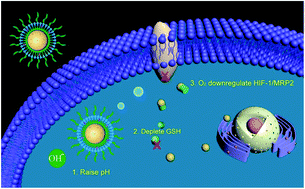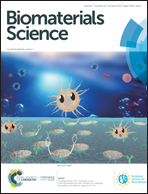Enhancement of cisplatin efficacy by lipid–CaO2 nanocarrier-mediated comprehensive modulation of the tumor microenvironment†
Abstract
Hypoxia, acidosis and high level of glutathione (GSH) are characteristic abnormalities of the tumor microenvironment (TME), which promote tumor progression, metastasis, and resistance to therapies. Previous attempts to improve therapeutic efficacy were limited to modifying individual TME elements. In this study, we proposed a comprehensive TME modulation strategy that modifies multiple elements of the TME in order to enhance cisplatin anticancer efficacy. To do so, we prepared biocompatible lipid-coated CaO2/cisplatin nanoparticles (LipoCaO2/DDP) by the reverse microemulsion method. We imbued CaO2 with the following reverse-TME properties: O2 generation, increased pH value in tumor cells, and oxidation of intracellular glutathione. In vitro experiments showed that LipoCaO2/DDP could deplete GSH for preventing the binding of GSH to cisplatin. Simultaneously, CaO2 could significantly downregulate multidrug resistance-associated protein 2 (MRP2) by O2-dependent hypoxia-inducible factor 1 (HIF-1) inactivation. Hence, the complete drug-efflux pathway was blocked, and the anticancer effect of cisplatin was enhanced both in vitro and in vivo. Herein, we not only demonstrated the GSH depletion capacity of CaO2 for the first time, but also provided a new comprehensive therapeutic strategy to overcome therapeutic resistance caused by multiple factors in the TME.



 Please wait while we load your content...
Please wait while we load your content...